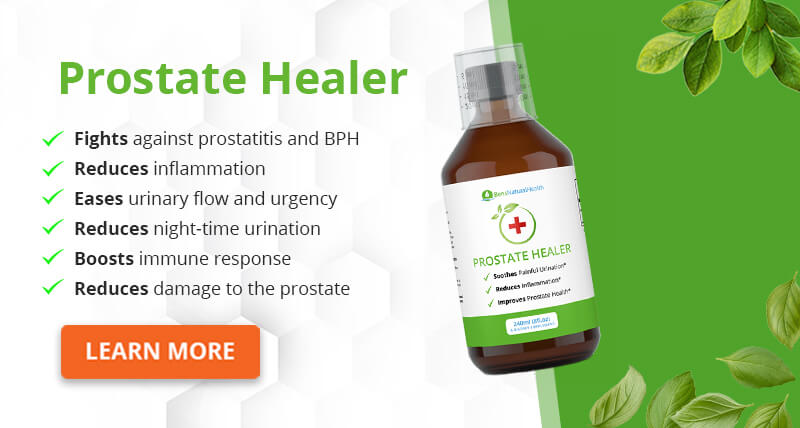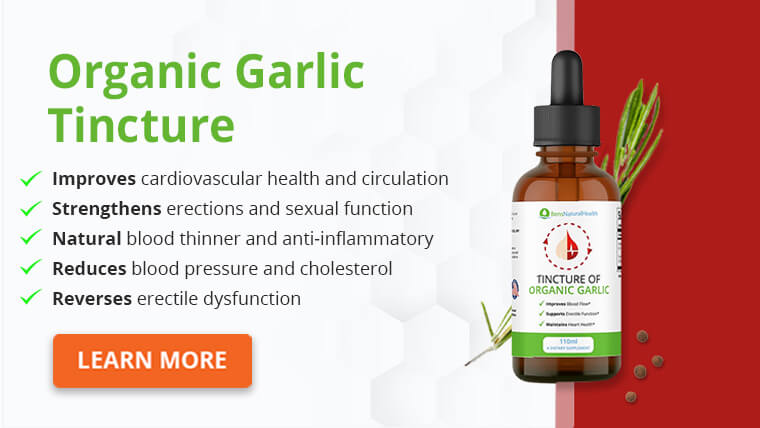- What is a lymphocele on the shaft?
- What does lymphocele on the shaft feel like?
- Lymphoceles vs other penis problems
- Signs and symptoms
- What causes a lymphocele on the shaft?
- Treatment Options
- How long does a lymphocele on the shaft take to heal?
- What if your lymphocele on the shaft won’t go away?
- Other tips for a healthy lymphatic system
- Ben's Organic Garlic Tincture
- Conclusion
- Source
Finding unexpected lumps, bumps, or sores on your private parts can be worrisome, but don’t worry—we’re here to help!
While some issues like razor burn, pimples, or ingrown hairs are usually not a big deal, others, like unusual discharge, herpes bumps, or swelling, foreskin redness, swelling, and tightness might signal a health concern.
Now, let’s talk about those mysterious lumps on the shaft. A sudden appearance of firm swelling on the shaft of the penis post-sex or masturbation—often caused by something called penis lymphocele. The good news? It’s usually harmless and tends to go away on its own without causing permanent changes.
To help with healing, it’s a good idea to take a break from intimate activities for a while. If the swelling persists, gets worse, or if you experience pain, it’s best to consult with your healthcare provider or urologist for guidance. They can provide expert advice to address any concerns about your intimate health.
What is a lymphocele on the shaft?
Lymphocele is a medical term that means a lump full of lymph fluid. This fluid accumulates in tanks or pockets that appear in the form of mass under your skin.
When there is a blockage in the lymph channels, that’s when you notice swelling or lumps appearing on your penis.
The lymphatic system is in charge of carrying lymph fluid through the body. When the lymph system works properly, it ensures the optimal functioning of the immune system.
Any form of injury, whether from surgery, rough sex, or vigorous masturbation, can affect the lymph nodes and cause a temporary blockage of lymph fluid.
A lymphocele on the shaft is usually a self-limiting condition. It doesn’t cause any harmful long-term effects on the penis tissue.
Lymphocele is not a sexually transmitted disease or the result of poor hygiene. The lymphocele lumps on the shaft don’t often cause pain. But, if they get bigger, men can experience soreness and other symptoms.
What does lymphocele on the shaft feel like?
When something blocks the lymphatic system, it traps the lymph fluid in a little bubble. The fluid has nowhere left to go, which ends up causing small bumps on the surface of the skin. If the bump moves around under the skin as you are trying to lift it, it might be something else, like a sebaceous cyst.
These lymphocele lumps on the shaft can feel hard – quite like a small marble. But they can also feel squishy and soft.
Men who had penile lymphocele before might get it again. Especially if they engage in rough intercourse or intense masturbation sessions. That’s because the penile tissues are delicate, sensitive, and easy to damage.
A lymphocele on the shaft often looks like small bumps on the top of the penis, just under the head. The penis bumps are a flesh-colored collection of fluid. The lymphocele shouldn’t appear ulcerated in any way, and it shouldn’t leak fluid.
Lymphoceles vs other penis problems
In order to understand what lymphoceles look like, it is important to compare them with other abnormalities that can affect the skin of the penis.
Sebaceous cysts
Lymphoceles are often confused with sebaceous cysts. These cysts are yellow lumps with relatively firm surfaces.
They can form anywhere in the genital area and occur due to blocked-up glands. They look and feel like small hard balls.
Sores and warts
Lymphoceles are different from other penis problems, such as penis sores or genital warts. Bumps are not usually painful unless you apply too much pressure on them.
Penis sores are very painful and become sensitive, inflamed, itchy, and red. Sores are often caused by sexually transmitted infections.
They can appear on your scrotum, pubic area, buttocks, upper thighs, and mouth.
Genital warts, on the other hand, are caused by HPV. These warts are small penis bumps that can develop on or around the anal or genital area. They look like soft fleshy growths and can cause itchiness, pain, and discomfort.
Pearly penile papules
Then there are pearly penile papules (PPP). They are very small benign growths that form near the penis head.
These bumps typically form in rows and look like pearls or white spots. They can also have a pink or yellow color.
Peyronie’s disease
Peyronie’s disease impacts the penis by causing the formation of scar tissue in the tunica albuginea. This scar tissue loses its elasticity, leading to a deformity in the penis.
The tunica albuginea, also known as the white coat, is a thick layer of tissue that surrounds the corpora cavernosa. Its main roles include promoting penile shortening, ensuring rigidity, and participating in the veno-occlusive mechanism.
Peyronie’s disease can result in a reduction in penile length and significant psychological consequences. It also induces a curvature during erection, giving rise to various issues, including difficulties with sexual function.

Signs and symptoms
Most lymphoceles don’t cause any symptoms. But, if the lymphocele grows, it can affect the body.
How fast the lymphocele lump on the shaft grows can vary from patient to patient. But, when it does, it starts to press against the nearby structures and creates symptoms.
According to studies, the lymphoceles became symptomatic in 5% to 10% of patients. In cases such as these, patients can experience:
- Redness of the skin
- Constipation
- Urinary frequency
- Fever
- Pain
- Obstructive uropathy
- Deep vein thrombosis
Large lymphoceles cause leg swelling, local discomfort, and pain. What kind of symptoms you experience will vary based on where the lymphatic fluid goes.
Talk to a specialist if you notice any lymphocele symptoms or problems with the penis. Symptoms often require treatment.
What causes a lymphocele on the shaft?
A lymphocele lump on the shaft usually arises due to tissue trauma and friction. A soft tissue injury can result in lymphatic disruption and cause a lymphocele on the shaft.
The main culprits of lymphocele lumps are rough sex, masturbation, or complications from surgical procedures.
Rough sex
Prolonged and vigorous sex can affect the lymph channels and lead to temporary blockage.
Intense intercourse with a partner causes friction, which can irritate the penis skin. This is a common problem when there is not enough lubrication.
Rubbing against the body wears away the upper layer of the skin. This exposes the sensitive layer, which is packed with nerves and connective tissue.
Some people find that lubricated condoms are easier to work with than non-lubricated condoms. But, just because a condom is lubricated, it doesn’t mean it offers enough lubrication for penetration. When you use a lubricated latex condom, you may also want to add extra lubricant.
Intense masturbation
Using rough masturbation techniques can cause a lot of friction. The skin can become red and sore. Gripping the penis too hard can affect the lymphatic system. If the lymph vessels develop temporary blockage, you may develop lymphocele lumps.
Repeated trauma can further block the lymph vessel and cause swelling.
Complications from surgical procedures
Lymphocele can occur as a post-surgical complication. Some surgeries can injure the lymphatic system and cause penis lumps.
These can include lymphadenectomy, kidney transplant, prostatectomy, and radical pelvic surgery.
Most lymphoceles appear within 3 to 8 weeks after surgery. But, they can also develop 1-year post-surgery.
Based on recent statistics, inguinal lymphocele is a common complication of surgery in the groin, with an incidence rate of 1% to 87%.
Penis bumps are also common and may require treatment. If you don’t treat the lymphocele on time, it can affect the blood flow and start compressing the surrounding blood vessels.
Poor blood supply can increase the risk of infection, problems with erection, and delay wound healing.
If you already experience erectile dysfunction and develop a lymphocele after surgery, talk to a healthcare provider.
Treatment Options
Many people want to know how to treat a lymphocele on the shaft. Lymphocele lumps on the shaft from rough sex or masturbation often don’t require any treatment.
Asymptomatic lymphoceles are less than 100 ml and resolve on their own. There is no need to take any medicine.
But, if the lymphocele on the shaft is large and can’t be spontaneously resorbed, then it may require a more aggressive treatment approach. These include:
- catheter drainage
- fine-needle aspiration
- sclerotherapy
- surgical marsupialization
Lymphoceles that last for over 6 months and cause symptoms can be reduced with CT scan-guided percutaneous needle aspiration.
In the meantime, focus on improving penis health. Make healthy choices. Eat well-balanced meals, stay active, and keep a healthy weight.
This way, you reduce the odds of developing high blood pressure, diabetes, and high cholesterol – these are major risk factors for erectile dysfunction.
Practice good hygiene and regularly wash the penis after sex with soap and water. Be sexually responsible by wearing a condom.
Or, if you have unprotected sex, make sure your partner or partners are free of sexually transmitted diseases.

How long does a lymphocele on the shaft take to heal?
The healing process for lymphocele lumps on the shaft varies from person to person. It can take a week to a month for it to heal.
Some patients notice a spontaneous recovery in 6 to 8 weeks. For others, the lymphocele on the shaft goes away in 1 to 2 weeks.
To boost the natural healing process and reduce the lump faster, avoid masturbation and intercourse for at least 3 to 4 weeks – or until the lymphocele on the shaft heals.
If swelling or irritation lasts for a couple of months or keeps reappearing, you might want to see a urologist.
What if your lymphocele on the shaft won’t go away?
If the lymphocele on the shaft won’t go away, talk to a doctor. Usually, the puffy lump subsides if you leave it alone.
People often book an appointment with a urologist if they have pain, discomfort, prolonged redness, irritation, and inflammation.
Many other problems can affect the penis. These include sexually transmitted diseases, yeast infections, ejaculation problems, penile cancer, and more.
Untreated STDs can lead to a range of health problems. They can cause pain around the pelvis, penis discharge, itching, burning sensations, blisters, bumps, or penis sores.
Those affected may also have to go to the bathroom more often or experience a change in bowel movements. Be sure to maintain adequate penis health and avoid any STDs.
If you develop STDs alongside lymphoceles on the shaft, get the necessary treatment.
Other tips for a healthy lymphatic system
You can support your lymphatic system through healthy lifestyle choices. These include:
Exercise
Any form of physical activity can help the lymph move through the lymphatic system. Regular movement promotes blood flow, curbs swelling, and makes the muscles contract. This enables the body to push lymph through the lymph vessels.
In the meantime, you can improve your range of motion and flexibility and reduce the risk of obesity and health problems, such as heart disease and diabetes. Options like Kegels, aerobics, and resistance training can help.
Food
Nutrients play a key role in the development of the immune system. Your body needs all the minerals, vitamins, and nutrients it can get to be able to fight off any pathogens.
Foods that can benefit your lymphatic system are leafy greens, cranberries, turmeric, mushrooms, garlic, etc. Try to eat a balanced diet on a regular basis.
Get Your FREE Low Testosterone Diet Plan
- The ultimate testosterone boosting diet
- Combined with exercise & lifestyle advice
- Developed exclusively by our nutritionist
Hydration
The more water you drink, the easier it is for the body to function. But, when you experience dehydration, there is not enough fluid flow toward the tissues. So, everything becomes stagnant.
For the fluids to keep flowing and for the body to filter out the toxins, you need to drink water. You can also enjoy tea, freshly squeezed fruit juice, or other products.
Just make sure to keep the coffee, soda, alcohol, and other sweet drinks to a minimum. Experts often associate these drinks with dehydration.
Abdominal breathing exercises
Deep breathing exercises can be a practical tool for promoting lymphatic structures. The up-and-down movement of the diaphragm during these types of exercises creates a favorable environment for lymphatic fluid flow, which can aid the body.
Ben’s Organic Garlic Tincture
Research has shown that garlic can improve blood flow throughout the body, which could increase blood flow to the penis and help support erections.
Ben’s Organic Garlic Tincture is a powerful natural antiviral and antibacterial compound designed to improve blood flow, strengthen erections, improve heart health, and lower blood pressure and cholesterol.
Garlic improves circulation by improving the flow of blood through small blood vessels and capillaries. In larger doses, it can help clear capillaries and address erectile dysfunction.

Conclusion
Lymphoceles on the penis can form from very intensive masturbation or intercourse. It can also occur as a post-surgical complication.
Lymphoceles from friction can go away on their own without medicine or any treatment. The best way to resolve the lymphocele on the shaft is to refrain from sex and masturbation until it can heal completely.
Post-surgical complications are often more complex and may require intensive treatment. But only a doctor can decide whether you need treatment to take care of the lymphocele.
If the lymphocele persists for a couple of months or keeps reappearing, talk to a doctor. They can suggest some practical ways for you to manage the bumps on the penis.
Explore More








